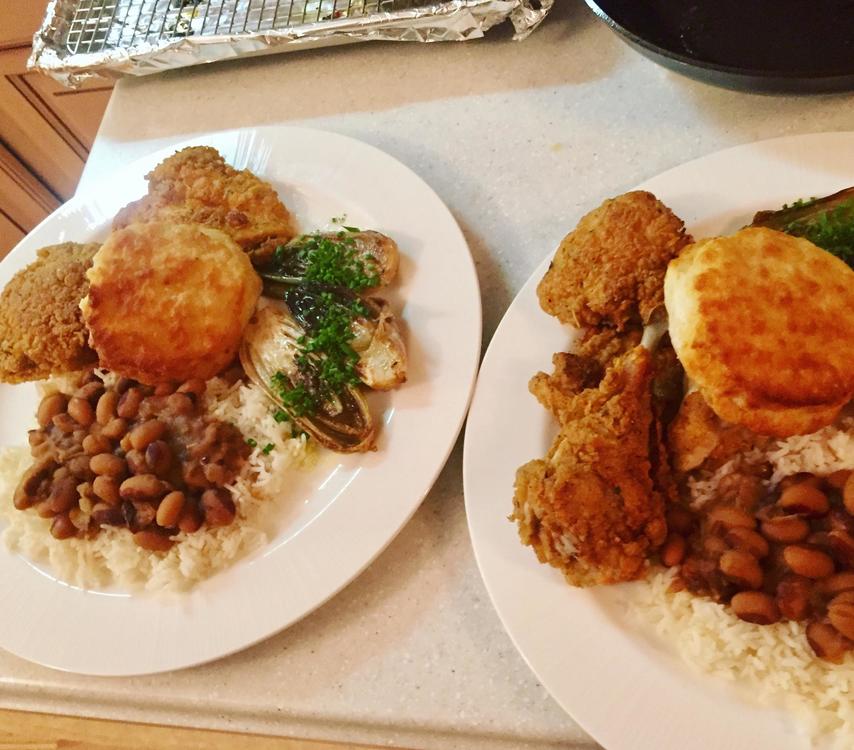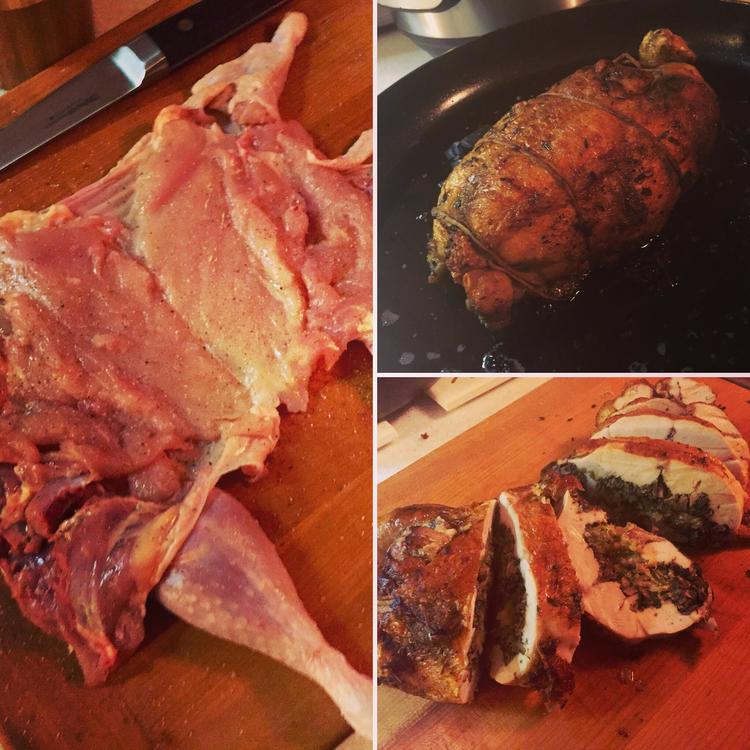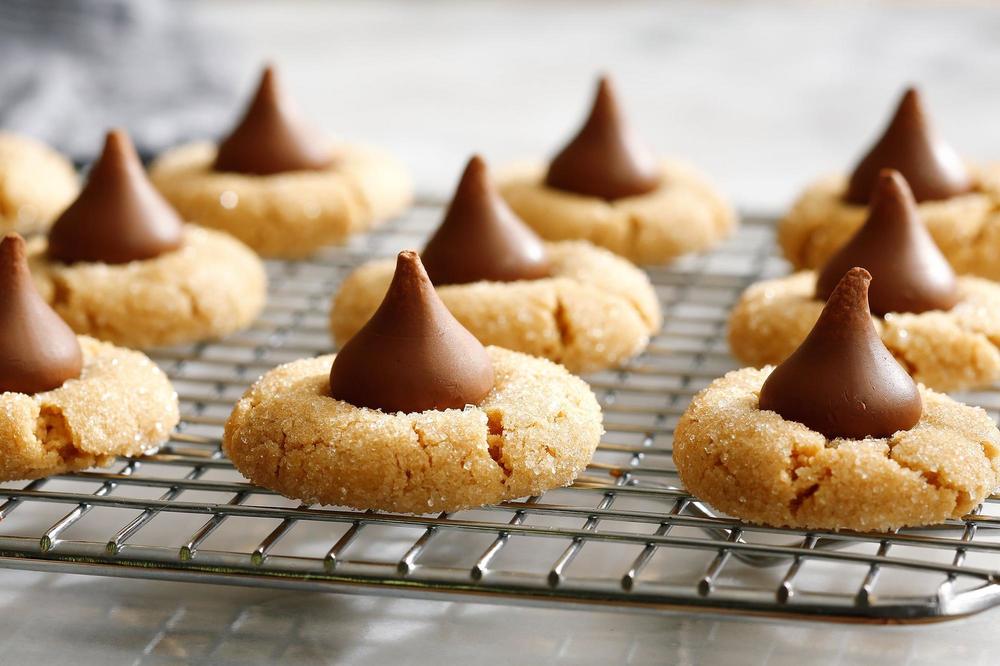-
Posts
1,807 -
Joined
-
Last visited
Content Type
Profiles
Forums
Store
Help Articles
Everything posted by btbyrd
-
The oil is less important than the therms. If you're therming right, there's going to be plenty of smoke regardless of what oil you use. And possibly fire. That said, rice bran, avocado, and clarified butter or ghee are all good fats for searing. Peanut oil and refined/light olive oil are good, more widely available options.
-
Use the therms. But not too many, or you'll get bad results. (Images sourced from Giphy.com) On a related note, I'm going to be picking up a Japanese konro grill in the near future, which should be great for searing. I have my eye on the medium one that Korin sells, which is the one you tend to see featured. It's the center of this ChefSteps family meal:
-
-
20% off at MTC Kitchen through NYE with code MTCYESALE. I picked up a konro grill and some ishiri (fish sauce made from squid guts). EDIT: some exclusions apply, including food items. So I saved on the grill, but not on the fish sauce.
-
I'm sure they're nice and all, but I hate rivets and the prices are silly.
-
From a performance standpoint, I don't know that the Dartos are significantly different from other carbon steel pans of the same thickness. The main advantages of carbon steel are in its thermal mass and its kinda-sorta-mostly nonstick properties, and those are things you get with any carbon steel pan of sufficient thickness. I don't know that any Darto or Matfer or deBuyer carbon steel will outcook another Darto or Matfer or deBuyer that's the same thickness. From a cooking perspective, they're all pretty similar. The main reasons I like the Darto stuff go beyond performance. Darto is an extremely small company focusing on making basically one product. Their pans have the look and feel of something made by a craftsperson rather than something made in giant factory by robots or anonymous worker bees. And they're quite reasonably priced, even if they do cost a bit more than something from a larger manufacturer. The seamless design is something that, to my knowledge, only one other company does, and their pans are much more expensive. And I just think the Dartos look cool. They elicit comments. The same can't be said of my Matfer.
-
-
My mother always made these around the holidays: OOOOOOOOOOOOOOOOOH... "Holiday nibbles." Nevermind.
-
If you'd like to read more about how dyes with different molecular sizes differentially penetrate meat, Genuine Ideas has a good blog post about it. He's also got some similar posts about nitrate penetration for cured meats, and a couple nice articles on brining. It's all worth a read. EDIT: As it turns out, Greg Blonder (who runs Genuine Ideas) is the resident science adviser at Amazing Ribs. I suspected his involvement when I saw the dyes come out...
-
In Soviet Russia, kettle boils you!
-
After the bag's open, treat them like ordinary leftovers.
- 1 reply
-
- 3
-

-
The Jaccarding technique I was suggesting is purely mechanical and relies on the use of the vacuum bag to push the marinade into the channels created by the needler. If you coat needled meat and put it in a vacuum chamber, there's nothing to press the marinade into the holes, so I wouldn't expect that to be a useful way to do it. A quick reply to your other points: - I don't know why beef would be magically different than fish or chicken. If anything, I'd expect it to uptake even less marinade since it's more dense and robust than chicken and fish, which can be easily damaged at high vacuum levels. - Genuine Ideas is legit, and I trust it more than intuitions, industry lore, and marketing nonsense put forward by manufacturers of vacuum marinaders/tumblers. Dave Arnold cites it; I don't feel bad about citing it either. - Neither of the second set of sources that I linked to mention beef. The section you quoted is about chicken. That quote is also about the vacuum tumbling process, not vacuum marination per se. They attribute the difference in yield and uptake to tumbling rather than vacuum level. - As for the third study and its limited vacuum marination time, I don't think that matters. If you've ever made instant pickles or compressed watermelon in a vacuum machine, you know it only takes 30 seconds to shove a whole bunch of brine into something. It is almost instant. If there's no difference in uptake after 30 minutes, I don't think giving it more time is going to change things.
-
Sure. Genuine Ideas did a blog post on this called "Vacuum Marination Sucks" that provides a good overview. If you want to go down the meat science journal rabbithole, researchers at the University of Georgia and the USDA have repeatedly (1) found (2) that vacuum levels have no effect on the uptake of marinade by chicken. They conclude that "vacuum pressure during tumbling, as is widely practiced commercially, may not be necessary. The underlying principles for using vacuum pressure may be erroneous and should be examined further." Another study on the effect of vacuum marination on fish found that ""contrary to conventional industry belief, vacuum (9.2 kPa) during tumbling did not affect uptake of marinade." These articles suggest that the perceived benefits of marinating in a vacuum tumbler actually come from the tumbling, not the vacuum. I have yet to put a vaccum selaed bag of marinating meat in my dryer, but I can't say that I haven't considered it.
-
The benefits of vacuum marination are much exaggerated. But if you like doing an overnight marinade with herbs and oil, it also works quite well in a bag, vacuum or otherwise. This has the added bonus of allowing you to drop the meat straight "from the marinade" into the water bath. In an herb/oil marinade, time is what matters most, not temp... so a 1-2 hour SV cook won't compare to a 12 hour marinade. There's not a real substitute for time. Well... that's not entirely true... The best way to accelerate marinade uptake using vacuum is to use meat that has been Jaccarded or needled. Meat is dense. It is not like a sponge, and won't "suck up" marinades appreciably faster under vacuum. However, if you poke it through with hundreds of channels using a Jaccard, things change. You can get radically faster marinade/brine/whatever penetration using vacuum machines in conjunction with Jaccarding. I haven't heard this technique discussed, though I'm sure people have thought about it before. For lack of a better term, I call it "vacuum injection" of brines or marinades, given its similarity to ordinary, non-vacuum injection brining. But back to herb oil marinades... This Thanksgiving, I made two quarts of herb oil that I used to confit all the turkey. I basically fried a bunch of thyme, sage, marjoram, rosemary, bay, and herbs de provence at a very low temperature (under 250) in extra virgin olive oil and took it off the heat just before the bubbles stopped. There were some chili flakes in there too. Once it cooled to room temp, I strained it and used it all over everything. Sometime I'm going to experiment and create something similar using culinary essential oils (inspired in part by Dan Patterson's book with Mandy Aftel).
-
My thought has always been that if you have to resort to chemical solutions to your browning problem, your pan's not hot enough. Put down the bicarbonate and step away from the dextrose.
-
Whatever the smoke point of your oil is. And while it may be cooler than a very hot pan, the overall time your meat will have to spend in a hot pan is less.
-
It's almost impossible to sear properly in a home kitchen for lack of both BTUs and ventilation. If your pan is really hot enough to do the job you're asking it to do, you'll smoke out your kitchen in an instant. I do it outside or not at all. Searing over charcoal is excellent, but at that point I'd rather just grill the steaks over charcoal from start to finish. I hate torches for searing, even with the Searzall. I use the Searzall all the time, but not to finish steak. My favorite indoor searing strategy is deep frying. By searing all the sides at once, you get an extremely even sear with minimal risk of producing a temp gradation. I almost never cook steak SV anymore.
-
I'm sure the two-temp method produced good results. The question is if they're fundamentally better (or even discernibly different) results from using other temperatures. To my knowledge, nobody has tested that in any controlled way. PedroG outlined what such an experiment might look like, but I couldn't find anyone in the SV thread who actually took up the challenge. I would amend Pedro's initial proposed experiment to include weighing the meat before/after cooking to see if there's a significant difference in moisture loss (since that's what we're interested in). At any rate, PedroG's hypothesis wasn't arbitrary, and he outlined the reasons for thinking that the two step process might benefit cuts that have thick tendons. But is it actually true? Who knows. (Seriously, if anyone knows, let us know!) The "Enemy of Quality" part of me thinks it probably doesn't matter very much for something that you're going to cook until it's falling apart and then sauce with jus. Perceived juiciness in braises can be misleading anyway, given the mouth-coating and meat-coating gelatin that's all over the place. Hence my suggestion about weighing the meat in the experiment rather than relying on subjective measures. Anyway, I can't find anything anywhere about 136.5F (or whatever) being some sort of magic temperature, and that's the thing that seemed weirdest to me about the above procedure. That temp is not something that came up in the above posts from PedroG (who simply suggested that people cook below 140F for the initial step). Collagen will denature and protein will contract at 130F. It will do it more/faster at higher temperatures. I know I'm not telling you anything new here, but if someone could tell me anything new about how collagen behaves in the mid-130's, I'd much appreciate it.
-
The whole issue of enzymatic tenderization isn't really relevant to this discussion. The temps we're talking about are much too high. I also have a priori reasons to be suspicious of low-temp tenderization of beef (in large part because the enzymes are mostly inactive after the time involved in the beef aging process) but I don't want to go into them and give that theory any more publicity than it's already gotten. If low-temp enzymatic tenderization was a fantastic idea, MC or ChefSteps or someone other than random internet forum dudes would have made a big deal about it. But it isn't so they didn't. And not just because of liability issues (though those are heavy; most everyone I've seen who swears by the 105-122F stepwise SV tenderization process seems like a goon who would rather poison their family than try a proper triangle test to see if the risk was worth it). Enzymes aside, tissue contracts when you cook it. At 130F or 140F, it's still going to contract. There is nothing magical about 136.5F. If there is, I'd love to see a proper citation (or better yet, a well-done SV experiment on YouTube that isn't performed by goons). There's juice all over the place at 130F, even for just a couple hours. The idea that something's going to be radically more juicy if you cook it at 135F for 12 hours and then jump to 160F for another 12 hours seems like magical thinking to me. I'm willing to be persuaded. But... *citation needed
-
As soon as I saw the thread title, I was reminded that Daniel Patterson has a recipe for carrots slow roasted on a bed of coffee beans. Here's the basic technique. The full dish is in the Coi cookbook and can also be viewed at Serious Eats.
-
There's stuff that has sentimental value that I'd never get rid of (like my grandmother's cast iron pans). Then there are things that I simply wouldn't want to be without. Out of everything that's in my kitchen that doesn't fit in the first category, I try to make sure that it fits into the second category. Knives are the main exception.
-
If you have to wonder whether you're making yourself sick, you haven't made yourself sick. Yet. Leftover rice should be refrigerated as soon as it's cool enough to move to the fridge. Rice is a fantastic substrate for bacterial growth and it's not acidic or salty enough to fight off microbial invaders (unlike some of your other leftovers, which are comparably more hostile). If you need the rice to cool down faster, move it to a large bowl and fluff it with a spoon or rice paddle. It will cool off rapidly. Jarred minced garlic isn't raw. It's been cooked during the canning process, which is one of the many reasons it's not a full substitute for real raw garlic. Jarred garlic is also packaged in water, which creates an aerobic environment (where the threat from botulism arises in anaerobic environments like oil or a vacuum bag).






